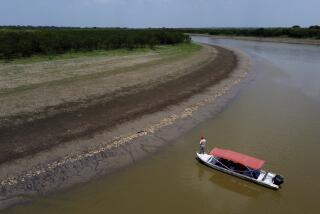Dolphins in Amazon to Get High-Tech Help
- Share via
Conservationists will use helicopters, ships, trucks and stretchers this summer to rescue fresh water pink dolphins from man-made dangers deep in the Amazon rain forest.
Until recent years, such rare dolphins have swum freely along the Amazon River and its tributaries. But dams, built in the last decade to create reservoirs for government-financed soybean and rice plantations, now are trapping the dolphins. Last year, about 200 dolphins died of starvation and exposure to the sun as a result.
In the July-November rainy season, the river rises to the top of the dams, allowing the dolphins to swim over them. But when the dry season arrives, the water levels drop, trapping the dolphins behind the dams.
The Amazon River dolphins are the largest and possibly the oldest of four species of fresh water dolphins; the others are found in Argentina, China and India.
These dolphins also are called pink dolphins because their normally light gray skin sometimes changes to pink and back again. The mammals also can be distinguished from their better-known marine cousins by their smaller eyes, longer snouts and unfused neck vertebrae, which allow them to turn their heads 90 degrees. The dolphins also have a type of sixth “finger” in the bones of the flipper, which helps them maneuver on and off mud banks to search for food.
Michael Bailey, director of Earthtrust, a Hawaii-based environmental group, and other conservationists from around the world plan in August to trap up to 150 dolphins and move them to nearby lakes and undammed streams in the rain forest.
More to Read
Sign up for Essential California
The most important California stories and recommendations in your inbox every morning.
You may occasionally receive promotional content from the Los Angeles Times.










